Deepcool Dracula Graphics Card Cooler Review

Deepcool cooler with this intimidating name is very large and heavy, and on top of everything take over three PCI-E slots next to it and is quite expensive. However, its cooling efficiency is truly unbeatable. Today we are going to talk about the second revision of this remarkable product.
About a year ago Deepcool Industries released a GPU cooler which was bloodthirstily called Dracula.
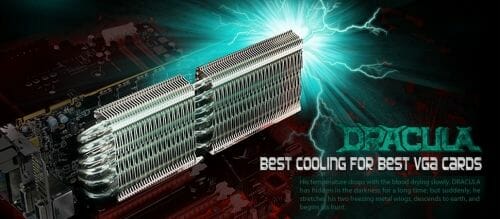
That model was a success, delivering very high performance and being compatible with a large number of graphics cards. But as AMD and Nvidia released new GPUs, the Dracula was found unsuitable for some of them. Particularly, the lowered position of the die of the Tahiti GPU called for certain modifications in the cooler’s base. Deepcool has responded to this by releasing the second revision of the Dracula. We’ll check out its features and performance in this review.
Technical Specifications and Recommended Pricing
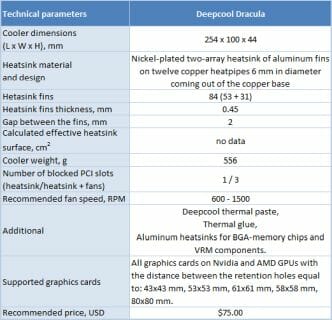
Packaging and Accessories
The cooler is shipped in a small black cardboard box with a minimum of information on its sides:
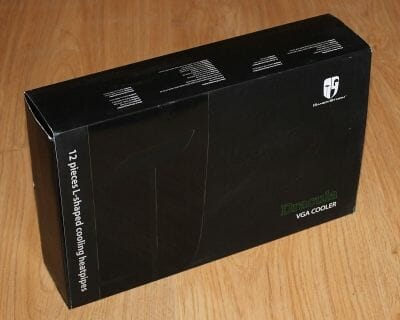
The designer of this packaging must have tried to imply certain connections with dark forces in general and with the famous vampire from Wallachia in particular.
Besides the main heatsink, the box contains the following:
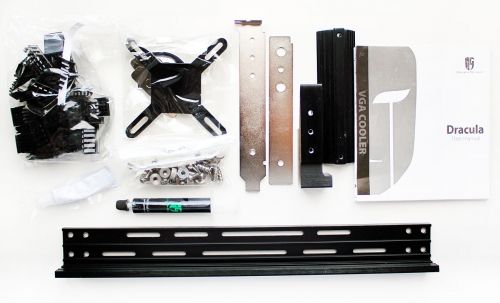
- 18 tall aluminum heatsinks for graphics memory chips;
- 9 low aluminum heatsinks for graphics memory chips;
- 6 narrow aluminum heatsinks for VRM components;
- Thermal glue for the heatsinks;
- Steel back-plate with an insulating pad;
- Screws, nuts, spacers and a wrench for them;
- Deepcool thermal paste;
- Mounting bracket and stiffening plate for the back panel of the system case;
- L-bar for fastening the fan frame;
- Heatsink for power components;
- Installation guide;
- Two fan faceplates;
- Deepcool sticker;
- Fan frame.
The Deepcool Dracula is shipped without fans. The following picture can help you identify each of the items included into the product box.
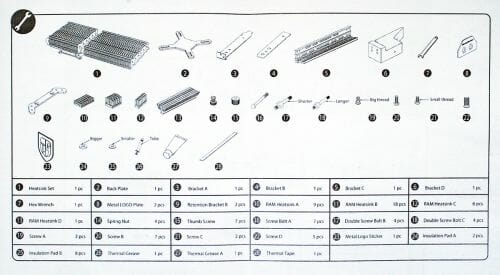
The cooler is manufactured in China. Its original version was priced at $55 but the recommended price of the updated Dracula is as high as $75, although there are no substantial changes in its design or accessories. The warranty period is 2 years.
Design and Functionality
The nickel-plated Dracula has 12 copper heat pipes that go out of the copper base and pierce the two individual heatsink sections.
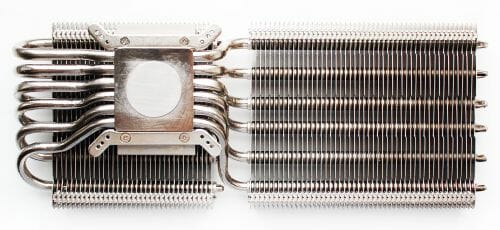
The pipes are 6 millimeters in diameter. They go out of the base, six to each side. There is a slim auxiliary heatsink above the cooler’s base.
The bigger section consists of 53 aluminum fins whereas the smaller section, of 31 fins. The fins are 0.45 millimeters thick and soldered to the pipes 2 millimeters apart from each other.
The whole heatsink measures 254x100x44 millimeters. The following drawing shows the details.
The heatsink is quite heavy at 556 grams. The fins are shaped and positioned in such a way that the top of the heatsink has a variable height.
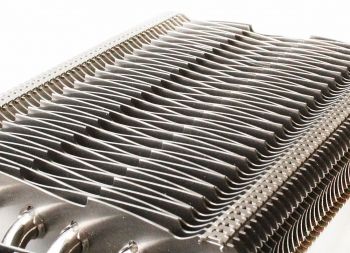
This is supposed to reduce resistance to the air flow and keep the cooler efficient at low speeds. The heat pipes pierce the heatsink in a straight line. They are spaced 9 to 11 millimeters from each other.
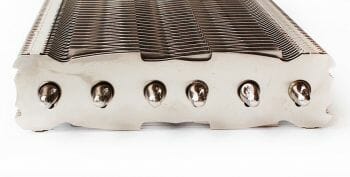
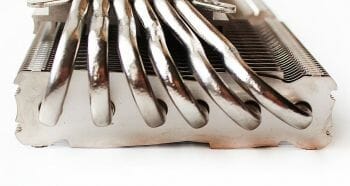
The fins, heat pipes and cooler base are all soldered to each other, so the whole arrangement is very robust and solid.
The pipes are laid in the base 1 to 1.5 millimeters from each other.

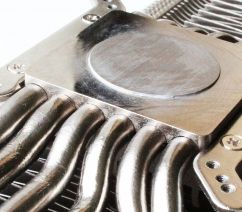
The contact spot of the revised Dracula has a round protrusion which is meant to touch the low-profile die of AMD’s new GPUs. The original Dracula had a mirror-like base, but the new revision shows a rather mediocre finish:
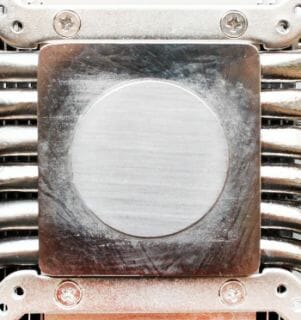
It is perfectly flat, though, so we’ve got an ideal thermal grease imprint on our AMD Tahiti chip.By the way, here’s a photo of the dismantled base of the cooler from a Chinese site. It proves that the Dracula really has 12 heat pipes.
It’s hard to tell if this design is more efficient than six pipes but at least we can make sure the pipes are indeed soldered to the base.
Compatibility and Installation
It is exceedingly simple to install the Dracula on any of the supported GPU models. You can have a look at the following picture to find out which mounting frames you need to fasten to the cooler’s base and what mounting holes to use.

The abundance of mounting holes makes the Dracula compatible with as many GPUs as possible. However, its compatibility may be limited by the size or nonstandard positioning of components on an original PCB.
The heatsink is fastened on the GPU by means of threaded pins (there are several kinds of such pins in the product box) which are screwed into the mounting plates.
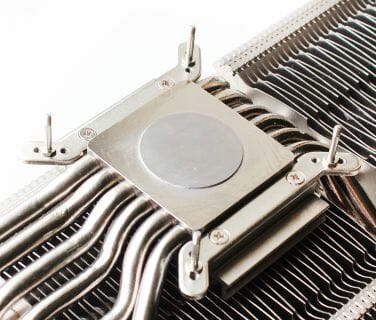
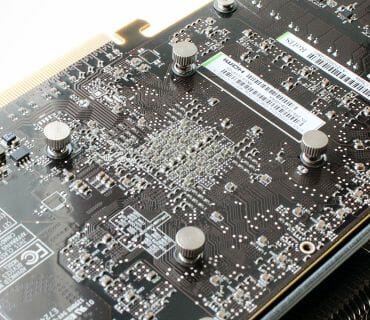
Then you apply some thermal grease on your GPU, mount the heatsink and secure it with spring-loaded nuts from the other side. You need to use a back-plate on some graphics cards but we did without one on our Radeon HD 7970. After the quick and easy procedure the Dracula was firmly seated on our card.
It made the card longer by 20 millimeters and taller by 10 millimeters, by the way.
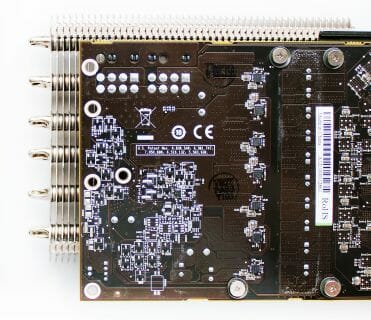
Neither the length nor height was a problem with us, though. Next, we plugged the card into our mainboard’s PCI Express slot and proceeded to mount fans.
To do this, you replace the mounting bracket of the nearest expansion slot with the bracket included into the cooler’s box:
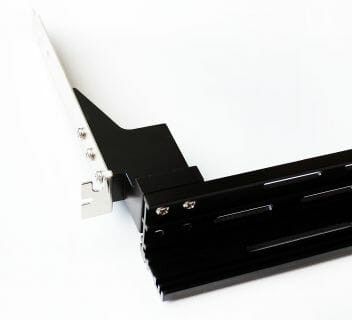
It is easier to install the bracket with the frame and fans already attached.
It is fastened not only with one screw from above but also with a stiffening plate on the exterior of the back panel of the system case. The resulting arrangement blocks as many as three PCI Express slots on the mainboard:
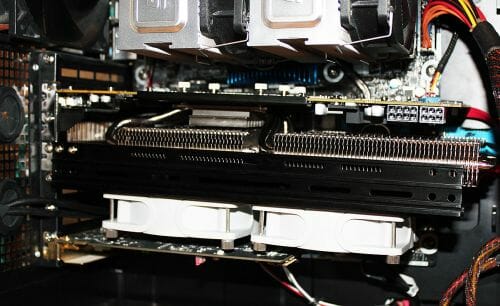
You can install 92, 120 and even 140mm fans on the frame if no mainboard components get in the way. For our tests we installed two 92mm and two 120mm fans. Let’s proceed to our testing now.
Testbed and Methods
The tests were performed in a closed system case. Our testbed was configured as follows:
- Mainboard: Intel Siler DX79SI (Intel X79 Express, LGA 2011, BIOS 0494 from 04/24/2012);
- CPU: Intel Core i7-3960X Extreme Edition, 3.3 GHz, 1.2 V, 6 x 256 KB L2, 15 MB L3 (Sandy Bridge-E, C1, 1.2 V, 6×256 KB L2, 15 MB L3);
- CPU cooler: Phanteks PH-TC14PE (2 135 mm, 900 RPM);
- Thermal interface: ARCTIC MX-4 (for all coolers);
- System memory: DDR3 4 x 4GB Mushkin Redline (Spec: 2133 MHz / 9-11-10-28 / 1.65 V);
- Graphics card: MSI R7970 Lightning 3 GB/384 bit GDDR5, 1140/7160 MHz;
- System drive: Crucial m4 256 GB SSD (SATA-III,CT256M4SSD2, BIOS v0009);
- Drive for programs and games: Western Digital VelociRaptor (300GB, SATA-II, 10000 RPM, 16MB cache, NCQ) inside Scythe Quiet Drive 3.5” HDD silencer and cooler;
- Backup drive: Samsung Ecogreen F4 HD204UI (SATA-II, 2 TB, 5400 RPM, 32 MB, NCQ);
- System case: Antec Twelve Hundred (front panel: three Noiseblocker NB-Multiframe S-Series MF12-S2 fans at 1020 RPM; back panel: two Noiseblocker NB-BlackSilent PRO PL-1 fans at 1020 RPM; top panel: standard 200 mm fan at 400 RPM);
- Control and monitoring panel: Zalman ZM-MFC3;
- Power supply: Xigmatek “No Rules Power” NRP-HC1501 1500 W (with a default 140 mm fan);
- Monitor: Samsung S27A850D, 27”.
MS graphics card was overclocked to 1140/7160 MHz frequencies:
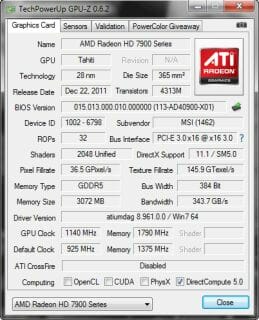
The testing programs were installed under Microsoft Windows 7 Ultimate x64 SP1. We used DirectX End-User Runtimes libraries (from November 2010), as well as AMD Catalyst graphics card drivers version 12.4. We warmed up the card with five runs of Aliens vs. Predator game in 2560×1440 resolution and with maximum image quality settings, 16x anisotropic filtering and 4x antialiasing:
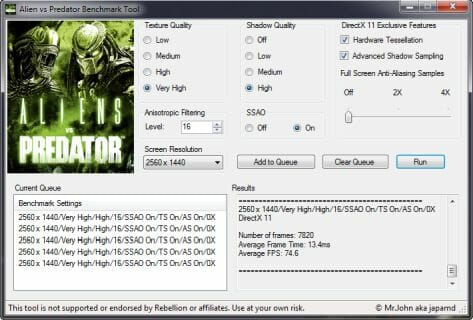
With the settings we used this test loads even a powerful graphics accelerator very heavily, but can’t damage it, which could be the case with FurMark (that is why we decided not to use this benchmark fully in our test session).
We used MSI Afterburner utility version 2.2.1 to monitor graphics card temperatures and frequencies and GPU-Z version 0.6.2 utility:
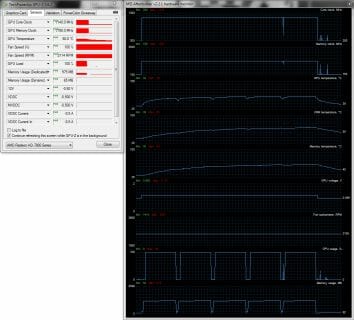
The tests were run at least twice. The temperature stabilization period between the two test cycles was about 10-12 minutes. The ambient temperature was checked next to the system case with an electronic thermometer with 0.1°C precision that allows monitoring the temperature changes over the past 6 hours. During our test session room temperature stayed around 25.0°C.
We used the same exact configuration and testing methodology as in our Arctic Accelero Xtreme 7970 review, so that we could compare the efficiency of the Deepcool Dracula against that of the best Radeon HD 7970 cooler out there. Besides, we also included the results obtained with MSI’s proprietary Twin Frozr IV cooler. We tested Deepcool Dracula with two 92 mm Deepcool UF92 fans in 1000-18000 RPM rotation speed range, and with two Deepcool UF120 fans in the 800-1500 RPM rotation speed range. The rotation speed of all fans was adjusted using our special controller by changing the voltage settings.
Performance
The following diagram shows how efficient the tested cooling systems are:
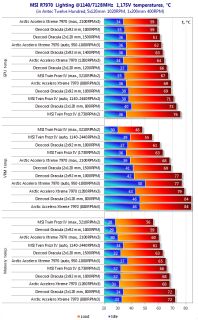
It is clear that the Deepcool Dracula is a highly efficient solution but using two 92mm fans with more focused air flow is no better in terms of efficiency than two 120mm fans. The Dracula is as good as the Arctic Accelero Xtreme 7970 and better than the MSI Twin Frozr IV in terms of GPU temperature. As for the temperature of the power components, it is inferior to the MSI but better than the Arctic. The difference from the other solutions isn’t large, though. The most important thing is that the Dracula can cope with a well-overclocked Radeon HD 7970 even at the minimum speed of the fans and irrespective of what fans you use (two 92mm fans at 1000 RPM or two 120mm fans at 800 RPM).
As for the noise factor, the Dracula comes without fans, so it is not quite correct to compare it with the Arctic or MSI in this respect. The user himself can choose suitable fans and install them using the universal fastener. The Deepcool UF series fans we used in our test are rather quiet but expensive, so you may want to prefer something cheaper, especially as the Dracula itself isn’t cheap. The free choice of fans and the easy way of replacing them are an indisputable advantage of the Dracula.
Conclusion
The arrival of the new generation of AMD-based graphics cards with higher clock rates and increased heat dissipation does not pose any problem for the new revision of the Deepcool Dracula cooler. It can still deliver devilishly high performance and can cope with overclocked top-end graphics cards at the minimum speed of its fans. In fact, we can only find two things about the new Dracula that we wish were different. It is quite expensive ($75 for a heatsink without any fans) and it blocks three adjacent expansion slots on the mainboard. It’s up to you to decide whether these are really serious issues for your specific case. Otherwise, the Dracula is a highly efficient cooler which is easy to install and has a reliable fastening mechanism.
How could it be improved further in the next revision? Well, we guess a better finish of the base would be appropriate for open-die GPUs. Wire brackets for installing fans right onto the heatsink, like in the V6000 model for example, could also come in very handy.